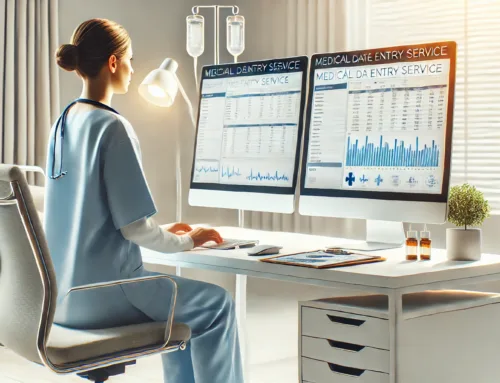As you navigate the intricate world of medical data entry, you may find yourself encountering a multitude of roles that play crucial parts in maintaining the accuracy and efficiency of healthcare systems. From deciphering medical codes to organizing patient demographics, each task holds its own significance in the grand scheme of patient care. Understanding the nuances of these common types of medical data entry jobs can provide you with a deeper insight into the intricate web of healthcare data management. Explore these roles further to uncover the vital contributions they make in the realm of medical information handling.
Medical Billing Data Entry
When it comes to medical data entry jobs, a common role you may encounter is Medical Billing Data Entry. In this position, training requirements typically include a high school diploma or equivalent, with some employers preferring candidates with an associate degree or certification in medical billing. The job outlook for Medical Billing Data Entry is promising, with an expected growth in demand due to an aging population and advancements in healthcare technology.
One of the advantages of working in Medical Billing Data Entry is the remote opportunities available. Many companies offer the flexibility to work from home, allowing you to create a comfortable work environment that suits your needs. This setup can save time and money on commuting while providing a better work-life balance.
Medical Coding Data Entry
Medical Coding Data Entry plays a crucial role in the healthcare industry by translating diagnoses, treatments, and procedures into universal medical codes. Accuracy standards are paramount in this role, as even small errors can have significant impacts on patient care, billing, and insurance reimbursement. Industry trends in medical coding data entry include the increasing use of technology such as coding software to streamline processes and reduce errors. Professionals in this field must stay updated on the latest coding guidelines and regulations to ensure compliance and accuracy in their work.
To excel in medical coding data entry, attention to detail is essential. Ensuring that each code accurately reflects the medical services provided is crucial for proper documentation and billing. By staying informed about industry trends, such as the shift towards more specific and detailed code sets, you can enhance your coding skills and adapt to changes in the field. Remember, precision and adherence to accuracy standards are key to success in medical coding data entry.
Electronic Medical Records Data Entry
Accuracy and precision are fundamental in Electronic Medical Records (EMR) Data Entry, where meticulous documentation of patient information is paramount. Ensuring data accuracy in EMR systems is crucial to providing quality patient care and maintaining compliance with healthcare regulations. To excel in this role, participating in specialized training programs can significantly enhance your skills and understanding of EMR software and data entry protocols.
One advantage of Electronic Medical Records Data Entry is the opportunity for remote work, offering flexibility and convenience. Remote work opportunities allow you to input patient information securely from the comfort of your home while adhering to strict data security protocols. It is essential to prioritize data security when handling sensitive patient information to maintain confidentiality and protect against potential breaches.
Medical Insurance Claims Data Entry
When it comes to Medical Insurance Claims Data Entry, having a strong attention to detail is crucial for accuracy in processing claims efficiently. Familiarity with software tools such as billing software, electronic health records systems, and spreadsheets is essential for managing and organizing claim data effectively. These skills will enable you to navigate the complexities of medical insurance claims processing with precision and proficiency.
Key Skills Needed
To excel in medical insurance claims data entry, having a sharp eye for detail is crucial. Specialized training in medical coding and billing procedures is essential for accuracy. Attention to detail is paramount as you input patient information, diagnosis codes, and treatment details into the system. A thorough understanding of medical terminology and insurance policies is necessary to ensure proper claims processing. Being meticulous in verifying data and detecting any errors or inconsistencies will prevent claim denials and delays in reimbursement.
Organizational skills are also key in managing large volumes of data efficiently. Prioritizing tasks, maintaining updated records, and meeting deadlines are vital in this role. Effective communication with healthcare providers, insurance companies, and patients may be required to clarify information or resolve discrepancies. Embracing technology and adapting to different software programs will streamline data entry processes and enhance productivity. By honing these skills, you can excel in medical insurance claims data entry and contribute to the smooth functioning of healthcare administrative operations.
Software Tools Used
For medical insurance claims data entry, utilizing specialized software tools is essential for efficient processing and management of information. These tools are designed to enhance data entry accuracy and speed, ensuring that all details are entered correctly and swiftly. One commonly used software tool is optical character recognition (OCR) technology, which allows for the scanning and conversion of physical documents into digital text. This aids in speeding up the data entry process while reducing the chances of manual errors.
Additionally, electronic health record (EHR) systems are frequently employed in medical insurance claims data entry to streamline the storage and retrieval of patient information. These systems enable quick access to relevant data, facilitating faster processing of insurance claims. Moreover, database management software such as SQL databases helps in organizing and maintaining vast amounts of data efficiently, contributing to improved data entry accuracy and speed in handling medical insurance claims. By leveraging these software tools, data entry professionals can enhance their productivity and ensure the seamless processing of medical insurance claims.
Hospital Records Data Entry
Hospital Records Data Entry plays a crucial role in maintaining the accuracy and accessibility of patient information within healthcare facilities. As a data entry specialist in this field, you are responsible for ensuring the organization of hospital records and implementing stringent data security measures to protect sensitive patient data.
Efficient hospital records organization is key to enabling healthcare providers quick access to patient information for effective decision-making. By accurately inputting and updating data into electronic systems, you contribute to the seamless flow of information within the healthcare setting. Moreover, implementing data security measures such as encryption protocols and access controls helps safeguard patient confidentiality and prevents unauthorized access to sensitive medical records.
Your attention to detail and commitment to data accuracy are vital in hospital records data entry to uphold the integrity and reliability of patient information. By adhering to established protocols and maintaining data security standards, you play a crucial role in supporting the delivery of quality healthcare services.
Clinical Trials Data Entry
Clinical Trials Data Entry involves the meticulous recording and management of data gathered during experimental studies evaluating the effectiveness and safety of new medical treatments. Ensuring data accuracy in clinical trials is paramount, as the information collected directly impacts the assessment of medical interventions. Every data point entered must be precise to maintain the integrity of the trial results.
Data security in clinical trials is crucial to protect sensitive information regarding participants’ health and personal details. Strict protocols are in place to safeguard this data from unauthorized access, ensuring confidentiality and compliance with regulations. As a Clinical Trials Data Entry specialist, your role is vital in upholding these standards. By accurately inputting and securely storing data, you contribute to the reliability and validity of the research findings.
Attention to detail and adherence to data security measures are fundamental aspects of Clinical Trials Data Entry. Your meticulous work plays a significant role in advancing medical knowledge and improving patient care.
Pharmaceutical Data Entry
Moving on from the meticulous data entry required in clinical trials, let’s now focus on Pharmaceutical Data Entry. In this role, data accuracy is paramount due to the critical nature of pharmaceutical information. As a pharmaceutical data entry specialist, you will be responsible for inputting and maintaining data related to drug development, manufacturing, and distribution. Ensuring that the information entered is precise and error-free is essential to guaranteeing the safety and efficacy of pharmaceutical products.
Industry regulations play a significant role in pharmaceutical data entry. You must adhere to strict guidelines set forth by regulatory bodies to maintain compliance and uphold data integrity. These regulations are in place to safeguard patient health and ensure the quality and safety of pharmaceutical products. Attention to detail and a thorough understanding of industry standards are crucial in this role to prevent errors and inaccuracies that could have serious consequences.
In pharmaceutical data entry, precision and adherence to industry regulations are key to maintaining the integrity of data and upholding the standards of the pharmaceutical industry.
Patient Demographics Data Entry
To accurately track and manage patient information, efficient and meticulous data entry of patient demographics is essential in healthcare settings. When handling patient demographics data entry, accuracy verification is crucial to ensure that all details are correctly recorded. Training programs play a key role in equipping data entry professionals with the necessary skills to input patient information accurately and efficiently.
- Attention to Detail: Each piece of information, from names to contact details, must be accurately entered to avoid errors in patient records.
- Confidentiality Measures: Upholding patient confidentiality is paramount, and strict adherence to privacy guidelines is essential when inputting sensitive demographic information.
- Software Familiarization: Proficiency with data entry software is vital for swift and accurate input of patient demographics. Training programs often include sessions on utilizing specific software tools effectively.
Medical Image Data Entry
When entering medical image data, you will encounter various file formats like DICOM and JPEG. Quality control processes are crucial to ensure accuracy in transcribing medical images. Familiarity with data entry software specific to medical imaging is essential for efficient processing.
Image File Formats
Navigating the realm of medical image data entry requires a solid understanding of various image file formats commonly used in healthcare settings. When dealing with medical image data entry, it is crucial to ensure data security by utilizing file formats that maintain confidentiality and integrity. Additionally, accuracy in data entry is of utmost importance to avoid errors that could impact patient care and diagnosis.
- JPEG (Joint Photographic Experts Group): A widely used format for medical images due to its high compression capabilities, making it easy to store and share images while maintaining quality.
- DICOM (Digital Imaging and Communications in Medicine): Specifically designed for medical imaging, DICOM files store not only images but also patient information, ensuring data accuracy and security.
- TIFF (Tagged Image File Format): Known for its lossless compression and ability to store multiple images in a single file, TIFF is favored for preserving image quality and details in medical data entry processes.
Understanding these image file formats is essential for efficient and accurate medical image data entry.
Quality Control Processes
Quality control processes play a vital role in ensuring the accuracy, integrity, and reliability of medical image data entry. Data accuracy verification is a crucial aspect of quality control, where each entry is meticulously checked to ensure precision. Error detection and correction mechanisms are implemented to rectify any inaccuracies promptly. By emphasizing these processes, the overall quality of the data is upheld, reducing the risk of errors in medical records.
In addition to accuracy, quality control processes also focus on data entry efficiency. Workflow optimization techniques are utilized to streamline the data entry process, allowing for quicker and more effective completion of tasks. By enhancing efficiency, medical facilities can improve productivity and ensure that patient information is accurately recorded in a timely manner. Implementing rigorous quality control measures not only enhances the quality of medical image data entry but also contributes to the overall effectiveness of healthcare operations.
Data Entry Software
Optimizing medical image data entry processes is crucial for maintaining accuracy and efficiency within healthcare facilities. When it comes to data entry software for medical image data entry, there are essential aspects to consider:
- Data Entry Accuracy: Utilize software that offers validation checks and error detection features to ensure accurate input of medical image data.
- Training Programs: Look for software that provides comprehensive training programs to educate staff on proper data entry techniques and the use of the software effectively.
- Data Entry Efficiency: Choose software that streamlines the data entry process, reducing manual tasks and increasing overall efficiency for faster turnaround times.
Prescription Medication Data Entry
When handling prescription medication data entry, it is crucial to maintain accuracy and attention to detail. Data accuracy in prescription medication data entry is paramount to ensure patient safety and regulatory compliance. Every digit and dosage must be entered correctly to prevent medication errors that could have serious consequences. Automation has significantly impacted prescription medication data entry by streamlining processes and reducing human error. Automated systems can flag potential issues, such as drug interactions or incorrect dosages, helping to improve overall accuracy and efficiency in data entry tasks. However, even with automation, human oversight remains essential to catch any discrepancies or anomalies that the technology may not detect. By combining the benefits of automation with meticulous manual review, healthcare professionals can uphold high standards of accuracy in prescription medication data entry, ultimately contributing to better patient outcomes and quality of care.
Frequently Asked Questions
Are There Opportunities for Remote Medical Data Entry Jobs?
Yes, there are remote work opportunities for medical data entry jobs. You may need specific training requirements, such as knowledge of medical terminology and software applications. These roles often require accuracy, attention to detail, and confidentiality.
What Software Skills Are Required for Medical Data Entry Positions?
To excel in medical data entry, you need strong Excel proficiency and familiarity with EMR systems. Training requirements may vary, but industry standards often prioritize these software skills. Stay up-to-date with evolving technology to succeed.
Is Prior Experience in Healthcare Necessary for These Jobs?
You don’t need prior healthcare experience for entry-level medical data entry jobs. While beneficial, transferable skills like attention to detail and on-the-job training can suffice. Your ability to learn quickly and adapt is key.
How Do Medical Data Entry Jobs Differ From General Data Entry Roles?
When comparing medical data entry jobs to general roles, you’ll notice distinct differences in training requirements and industry regulations. Medical data entry often demands specialized knowledge due to the sensitive nature of health information and compliance with strict healthcare guidelines.
Are There Specific Certifications That Can Enhance Job Prospects in This Field?
To enhance job prospects in medical data entry, specific certifications like RHIT or CCA can make a significant impact. Training requirements vary but typically include courses in medical terminology, coding, and compliance regulations.




